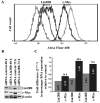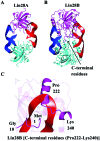A potential regulatory loop between Lin28B:miR‑212 in androgen-independent prostate cancer
- PMID: 25201220
- PMCID: PMC4215582
- DOI: 10.3892/ijo.2014.2647
A potential regulatory loop between Lin28B:miR‑212 in androgen-independent prostate cancer
Abstract
Lin28 is a family of RNA binding proteins and microRNA regulators. Two members of this family have been identified: Lin28A and Lin28B, which are encoded by genes localized in different chromosomes but share a high degree of sequence identity. The role of Lin28B in androgen-independent prostate cancer (AIPC) is not well understood. Lin28B is expressed in all grades of prostatic carcinomas and prostate cancer cell lines, but not in normal prostate tissue. In this study we found that Lin28B co-localized in the nucleus and cytoplasm of the DU145 AIPC. The expression of Lin28B protein positively correlated with the expression of the c-Myc protein in the prostate cancer cell lines and silencing of Lin28B also correlated with a lower expression of the c-Myc protein, but not with the downregulation of c-Myc messenger RNA (mRNA) in the DU145 AIPC cells. We hypothesized that Lin28B regul-ates the expression of c-Myc protein by altering intermediate c-Myc suppressors. Therefore, a microRNA profile of DU145 cells was performed after Lin28B siRNA silencing. Nineteen microRNAs were upregulated and eleven microRNAs were downregulated. The most upregulated microRNAs were miR-212 and miR-2278. Prior reports have found that miR-212 is suppressed in prostate cancer. We then ran TargetScan software to find potential target mRNAs of miR-212 and miR-2278, and it predicted Lin28B mRNA as a potential target of miR-212, but not miR-2278. TargetScan also predicted that c-Myc mRNA is not a potential target of miR-212 or miR-2278. These observations suggest that Lin28B:miR-212 may work as a regulatory loop in androgen-independent prostate cancer. Furthermore, we report a predictive 2-fold symmetric model generated by the superposition of the Lin28A structure onto the I-TASSER model of Lin28B. This structural model of Lin28B suggests that it shows unique microRNA binding characteristics. Thus, if Lin28B were to bind miRNAs in a manner similar to Lin28A, conformational changes would be necessary to prevent steric clashes in the C-terminal and linker regions between the CSD and ZNF domains.
Figures







Similar articles
-
Aberrant regulation of the LIN28A/LIN28B and let-7 loop in human malignant tumors and its effects on the hallmarks of cancer.Mol Cancer. 2015 Jun 30;14:125. doi: 10.1186/s12943-015-0402-5. Mol Cancer. 2015. PMID: 26123544 Free PMC article. Review.
-
MicroRNA-27a-5p regulation by promoter methylation and MYC signaling in prostate carcinogenesis.Cell Death Dis. 2018 Feb 7;9(2):167. doi: 10.1038/s41419-017-0241-y. Cell Death Dis. 2018. PMID: 29415999 Free PMC article.
-
Down-regulation of miR-200b-3p by low p73 contributes to the androgen-independence of prostate cancer cells.Prostate. 2013 Jul;73(10):1048-56. doi: 10.1002/pros.22652. Epub 2013 Feb 6. Prostate. 2013. PMID: 23389960
-
Changes in hypothalamic expression of the Lin28/let-7 system and related microRNAs during postnatal maturation and after experimental manipulations of puberty.Endocrinology. 2013 Feb;154(2):942-55. doi: 10.1210/en.2012-2006. Epub 2013 Jan 4. Endocrinology. 2013. PMID: 23291449 Free PMC article.
-
The role of Lin28A and Lin28B in cancer beyond Let-7.FEBS Lett. 2024 Dec;598(24):2963-2979. doi: 10.1002/1873-3468.15004. Epub 2024 Aug 16. FEBS Lett. 2024. PMID: 39152528 Free PMC article. Review.
Cited by
-
Circ_0004491 stimulates guanine nucleotide-binding protein alpha subunit to inhibit the malignant progression of oral squamous cell carcinoma by sponging miR-2278.J Dent Sci. 2023 Jan;18(1):237-247. doi: 10.1016/j.jds.2022.05.018. Epub 2022 Jun 15. J Dent Sci. 2023. PMID: 36643221 Free PMC article.
-
MicroRNA-212 negatively regulates starvation induced autophagy in prostate cancer cells by inhibiting SIRT1 and is a modulator of angiogenesis and cellular senescence.Oncotarget. 2015 Oct 27;6(33):34446-57. doi: 10.18632/oncotarget.5920. Oncotarget. 2015. PMID: 26439987 Free PMC article.
-
Tribbles-1 Expression and Its Function to Control Inflammatory Cytokines, Including Interleukin-8 Levels are Regulated by miRNAs in Macrophages and Prostate Cancer Cells.Front Immunol. 2020 Nov 27;11:574046. doi: 10.3389/fimmu.2020.574046. eCollection 2020. Front Immunol. 2020. PMID: 33329538 Free PMC article.
-
MicroRNAs in treatment-induced neuroendocrine differentiation in prostate cancer.Cancer Drug Resist. 2020;3(4):804-818. doi: 10.20517/cdr.2020.30. Epub 2020 Oct 12. Cancer Drug Resist. 2020. PMID: 33426506 Free PMC article.
-
Aberrant regulation of the LIN28A/LIN28B and let-7 loop in human malignant tumors and its effects on the hallmarks of cancer.Mol Cancer. 2015 Jun 30;14:125. doi: 10.1186/s12943-015-0402-5. Mol Cancer. 2015. PMID: 26123544 Free PMC article. Review.
References
-
- Jemal A, Bray F, Center MM, Ferlay J, Ward E, Forman D. Global cancer statistics. CA Cancer J Clin. 2011;61:69–90. - PubMed
-
- Crawford ED, Stone NN, Yu EY, et al. Challenges and recommendations for early identification of metastatic disease in prostate cancer. Urology. 2014;83:664–669. - PubMed
-
- Trendel JA. The hurdle of antiandrogen drug resistance: drug design strategies. Expert Opin Drug Discov. 2013;8:1491–1501. - PubMed
-
- Mirnezami AH, Pickard K, Zhang L, Primrose JN, Packham G. MicroRNAs: key players in carcinogenesis and novel therapeutic targets. Eur J Surg Oncol. 2009;35:339–347. - PubMed
-
- Ritchie W, Rasko JE, Flamant S. MicroRNA target prediction and validation. Adv Exp Med Biol. 2013;774:39–53. - PubMed
Publication types
MeSH terms
Substances
Grants and funding
LinkOut - more resources
Full Text Sources
Other Literature Sources
Medical
Research Materials
Miscellaneous

